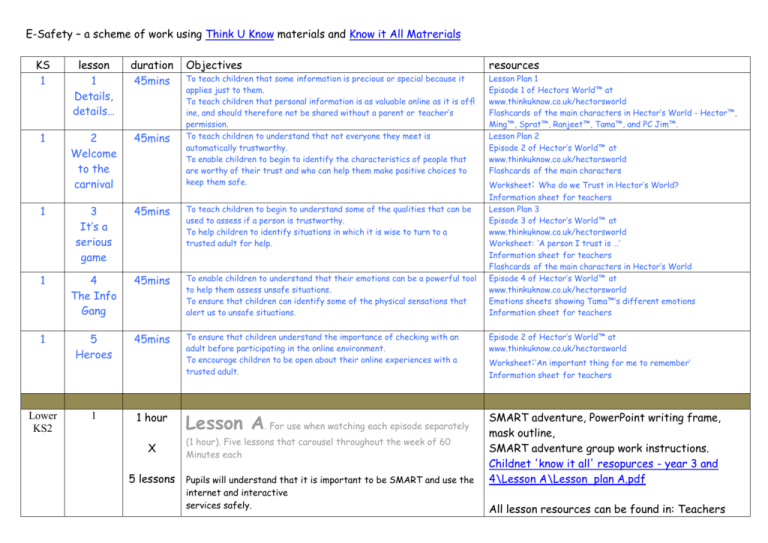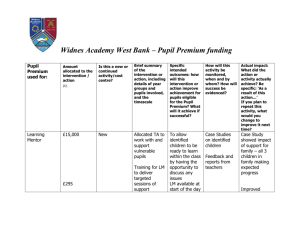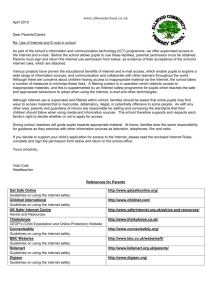E-safety scheme of work - Constantine Primary School
advertisement

E-Safety – a scheme of work using Think U Know materials and Know it All Matrerials KS 1 lesson 1 Details, details… duration 45mins 1 2 Welcome to the carnival 45mins 1 3 It’s a serious game 45mins To teach children to begin to understand some of the qualities that can be used to assess if a person is trustworthy. To help children to identify situations in which it is wise to turn to a trusted adult for help. 1 4 The Info Gang 45mins To enable children to understand that their emotions can be a powerful tool to help them assess unsafe situations. To ensure that children can identify some of the physical sensations that alert us to unsafe situations. 1 5 Heroes 45mins To ensure that children understand the importance of checking with an adult before participating in the online environment. To encourage children to be open about their online experiences with a trusted adult. Episode 2 of Hector’s World™ at www.thinkuknow.co.uk/hectorsworld 1 1 hour Lesson A. For use when watching each episode separately SMART adventure, PowerPoint writing frame, mask outline, SMART adventure group work instructions. Childnet 'know it all' resopurces - year 3 and 4\Lesson A\Lesson plan A.pdf Lower KS2 X Objectives resources To teach children that some information is precious or special because it applies just to them. To teach children that personal information is as valuable online as it is offl ine, and should therefore not be shared without a parent or teacher’s permission. To teach children to understand that not everyone they meet is automatically trustworthy. To enable children to begin to identify the characteristics of people that are worthy of their trust and who can help them make positive choices to keep them safe. Lesson Plan 1 Episode 1 of Hectors World™ at www.thinkuknow.co.uk/hectorsworld Flashcards of the main characters in Hector’s World - Hector™, Ming™, Sprat™, Ranjeet™, Tama™, and PC Jim™. Lesson Plan 2 Episode 2 of Hector’s World™ at www.thinkuknow.co.uk/hectorsworld Flashcards of the main characters (1 hour). Five lessons that carousel throughout the week of 60 Minutes each 5 lessons Pupils will understand that it is important to be SMART and use the internet and interactive services safely. Worksheet: Who do we Trust in Hector’s World? Information sheet for teachers Lesson Plan 3 Episode 3 of Hector’s World™ at www.thinkuknow.co.uk/hectorsworld Worksheet: ‘A person I trust is …’ Information sheet for teachers Flashcards of the main characters in Hector’s World Episode 4 of Hector’s World™ at www.thinkuknow.co.uk/hectorsworld Emotions sheets showing Tama™’s different emotions Information sheet for teachers Worksheet:‘An important thing for me to remember’ Information sheet for teachers All lesson resources can be found in: Teachers Lower KS2 1 45mins Lesson B For use when all episodes are viewed in one sitting during a whole or ICT/PSHE and Citizenship lesson (40 mins) Pupils will learn about using the internet and interactive services safely Upper KS2 1 65 Minutes Upper KS2 2 55mins Upper KS2 3 55mins Upper KS2 4 60mins Upper 5 60mins During this lesson children will be able to recognise that communication has a purpose and that there are many ways of communicating. They will understand that technology can provide effective ways of communicating with people, and the benefits of using technology to communicate, but realise that there are risks in using communication technologies and these can be reduced if appropriate behaviours are adopted. During this lesson children will have the opportunity to use the Cybercafé web site www.thinkuknow.co.uk/Cybercafé, learning how to navigate around the web site, what activities are available and how the characters can help them with the activities. You will find it essential to familiarise yourself with the site beforehand. Children will also be introduced to the SMARTthinking section of the Cybercafé and have the opportunity to discuss the messages and questions. This is an introduction to SMARTthinking; there will be plenty of opportunities in other lessons to develop pupils’ thinking about applying the SMARTthinking process to different situations. This would be a good opportunity to remind pupils about the school’s Acceptable Use Policy (AUP). During the lesson pupils will be able to recognise that communication has a purpose and that there are many ways of communicating. Technology can provide effective ways of communicating with people, but realise that there are risks in using communication technologies and these can be reduced if appropriate behaviours are adopted. More experienced pupils will be able to select appropriate technologies for specific purposes and justify their choices. This lesson begins with a whole-class introduction followed by pupils working in small groups to share ideas. These ideas are then shared with the whole class. Further group discussions follow and a plenary session is used to share and record what has been learned. During the lesson pupils will know there are safe and appropriate behaviours to use when sending and receiving e-mail. They will know that there are a range of strategies that they can use to deal with: viruses spamming bullying via e-mail During the lesson pupils will be able to find information on the internet, be aware that some of it is biased, and has to be verified, be able to evaluate and think critically planning>E-Safety>Childnet ‘know it all resources year 3 and 4’ Childnet 'know it all' resopurces - year 3 and 4\Lesson B\Lesson Plan B.pdf All lesson resources can be found in: Teachers planning>E-Safety>Childnet ‘know it all resources year 3 and 4’ Activity 1, Part 1: Communication Devices Activity Part 1: Cybercafé web site—www.thinkuknow.co.uk/cybercafé Activity Part 2: Decisions A—a Pupil Worksheet (Group A); Decisions B—a Pupil Worksheet (Group B); Decisions B and C—Pupil Worksheet (Group C) Activity Part 3: Glossary—a Pupil Recording sheet (pupils should note down terms and type in their meaning in the template) Plenary: SMARTthinking—a visual aid (reveal on interactive whiteboard); Stop, Think, Go!—a visual aid (reveal on interactive whiteboard) Activity 2, Part 1: Personal—a visual aid (pupils should have a copy each or one per group) Activity 2, Part 2: Who Would You Tell? – a Pupil Activity Sheet (each group should have a set of cards); Private Information Pupil Activity Sheet (each group should have 3 or 4 sets of these) Activity 3, Part 1: True or False?—a prompt sheet for the teacher Activity 3, Part 2: Statements—a Pupil Activity Sheet (one set per group, for pupils to cut up and sort accordingly) Scenarios—a Pupil Recording Sheet (pupils should use the cut-out statements from the above resource and sort them into relevant sections on an enlarged Scenarios sheet) Thinkuknow’s Cybercafé (www.thinkuknow.co.uk/cybercafé) Thinkuknow’s Cybercafé (www.thinkuknow.co.uk/Cybercafé) Activity 2: Evaluating Websites—a teacher presentation (download from about web sites. They should know that anyone can publish on the web and what to do if they come across anything that makes them feel uncomfortable on the Internet. Pupils should also know that companies can and do advertise on some web pages. KS2 Upper KS2 6 90mins Upper KS2 7 90mins Upper KS2 8 60mins Upper KS2 9 65 mins Pupils should understand what constitutes personal information and enhance their understanding of when and where it is appropriate to give out, personal details. They should know how to respond when asked for any personal information. They should be aware that anyone can participate in a chat room, that people in chat rooms do not always tell the truth, and that if they make their personal information available through an instant messaging service, it can be seen and used by others. Pupils will know there are safe and appropriate behaviours to use when receiving and sending text and multimedia messages. They will know there is a range of strategies that they can use to deal with: Spamming Cyber-bullying and/or offensive messages Requests for meeting, photographs etc. Pupils will learn about the level of personal detail it is safe to include in their own messages, and how to look after their phones. The approaches that they select and choose will depend on their previous experiences. Tell pupils that the focus of this lesson is about using messaging services on mobile phones, rather than on the use of mobile phones per se, as you are assuming that they know the risks with talking to people on the telephone and not giving out personal information etc. In this lesson pupils will identify irresponsible and unsafe behaviour when using the Internet and other Technologies, be able to suggest appropriate strategies to deal with this type of behaviour and be aware of the effect that irresponsible behaviour has on others. During this lesson pupils will consider how to create a safe online profi le. They will consider the most appropriate actions to take in keeping themselves safe, and will begin to develop strategies to keep themselves safe. They wil also be made aware of the possible consequences of not making the most appropriate choice. www.thinkuknow.co.uk/teacher); Websites—a prompt sheet or visual aid for pupils in Group A; Credibility Caterpillars—a pupil activity sheet (Groups B and C); A selection of bookmarked websites related to current topic of work. Activity 1: Access to one or two chat rooms (see list at the end of this lesson plan) Activity 3: Two gongs, cymbals, tambourines, chime bars or bells that can be sounded; a stop watch Activity 4: Thinkuknow’s Cybercafé website—www.thinkuknow.co.uk Activity 1: Thinkuknow’s Cybercafé website (www.thinkuknow.co.uk/Cybercafé) Activity 2: Text messages—a pupil activity sheet; cut out the messages and give each pupil in the group a card. Follow up (optional): Safety stars—a pupil recording sheet. Thinkuknow’s Cybercafé: www.thinkuknow.co.uk/Cybercafé; Visual aids. Scenarios—Pupil Task Sheet (one per group) Introducing the lesson—A whiteboard to list responses to the questions relating to Social Networking and how the pupils use them. Activity 1: Cybercafé—Internet access will be required for use within the classroom to enable the Cybercafé resource to be used. Website is www.thinkuknow.co.uk/Cybercafé.









